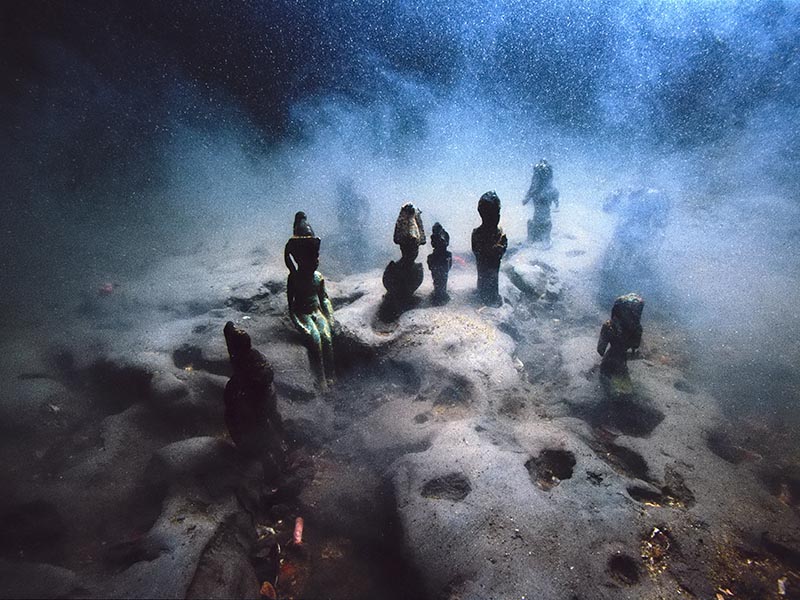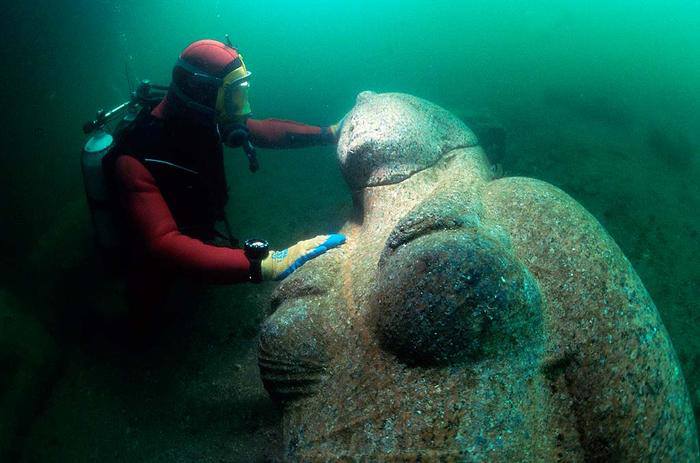“After 1,200 Years, the Ancient Egyptian City of Heracleion, Known as the Lost City of Heracleion, Has Been Found and Explored Underwater.”

Osirian statuettes of gods and goddesses found in situ on the floor of the sea at ancient Heracleion by Franck Goddio. Photo: Saint Louis Art Museum.org/ Christoph Gerigk ©Franck Goddio/Hilti Foundation
The Lost City Of Heracleion, which was once the largest port in Egypt, was discovered underwater after more than 2,000 years in the year 2000. Its legendary beginnings go back to as early as the 12th century BC, and it has many links to Ancient Greece.
Flourishing as long ago as the waning days of the Pharaohs, the city was destroyed over time, as it was weakened by a combination of earthquakes, tsunamis, and rising sea levels, according to archaeologists.
At the end of the 2nd century BC, most likely after a severe flood, the monumental buildings of Heracleion collapsed into the water. Some of its inhabitants stayed in what was left of the city during the Roman era and the beginning of Arab rule, but by the end of the eighth century AD, the rest of Heracleion had sunk beneath the Mediterranean.

Undersea explorer Franck Goddio discovering a statue hidden for more than 1200 years in the sunken city of Heracleion near Alexandria, Egypt. Credit: Christoph Gerigk/Facebook/Contemporary Explorations in Mythology LLC
Now, many of its incalculable treasures have been brought up from the watery depths to which they were banished and have been shown around the world, allowing us to get a glimpse into the Ancient Greek and Egyptian world.
Heracleion, better known by its original and Egyptian name Thonis, and sometimes called Thonis-Heracleion, was an ancient Egyptian port city located 32 km (20 miles) northeast of Alexandria on the Mediterranean Sea.
Its remains are located in Abu Qir Bay, currently 2.5 km off the coast, under just ten meters (thirty feet) of water. A stele found on the site indicates that it was one single city known by both its Egyptian and Greek names.

Before Alexandria was even a glimmer in Alexander the Great’s eye, Heracleion enjoyed its glory days as it served as the main port of entry into Egypt for the many ships arriving from all over the Greek world.
Thonis was originally built on some adjoining islands in the Nile Delta. It was intersected by canals with a number of separate harbors and anchorages. Its wharves, fantastic temples and tower-houses were linked by ferries, bridges, and pontoons.
The city was an emporion, or trading port, and in the Late Period of ancient Egypt, it was the country’s main port for international trade and collection of taxes.
Thonis had a large temple of Khonsou, son of Amun, who was known to the Greeks as Herakles, or Hercules. Later, the worship of Amun became more prominent. During the time when the city was at its zenith between the 6th and 4th centuries BC, a large temple dedicated to Amun-Gereb, the supreme god of Egypt at the time, was located in the middle of the city.
Pharaoh Nectanebo I made many additions to the temple in the 4th century B.C. Sanctuaries in Heracleion dedicated to Osiris, and other gods were famous for miraculous healing and attracted pilgrims from all around Egypt.
Spectacular religious ceremonies, temples, and monumental sculptures
The city was the site of the celebration of the “Mysteries of Osiris” each year during the month of Khoiak. These spectacular ceremonies involved a statue of the god transported in his ceremonial boat as it processed from the temple of Amun to his shrine in Canopus.
During the 2nd century BC just as the city was hit by the multiple disasters, the city of Alexandria, founded by Alexander the Great, superseded Heracleion as Egypt’s primary port.
Underwater explorer Franck Goddio and his team from the European institute for Underwater Archaeology, or IEASM, with the collaboration of the Egyptian Supreme Council, rediscovered the city after it sank into invisibility beneath the Mediterranean more than 2,000 years ago.
Since its foundation, the Institute has been directed by Franck Goddio who devotes himself entirely to underwater archaeology and the dissemination of knowledge gained through these discoveries through the publication of books and articles, as well as the organization of exhibitions.
Goddio’s in-depth website explains the incredible finds he made during the expedition. As is stated on the website, “He has also solved a historic enigma that has puzzled Egyptologists over the years: the archaeological material has revealed that Heracleion and Thonis were in fact one and the same city with two names; Heracleion being the name of the city for the Greeks and Thonis for the Egyptians.”
Furthermore, it is written on Goddio’s website that: “The objects recovered from the excavations illustrate the cities’ beauty and glory, the magnificence of their grand temples and the abundance of historic evidence: colossal statues, inscriptions and architectural elements, jewelry and coins, ritual objects and ceramics—a civilization frozen in time.”
The priceless treasures Goddio is responsible for discovering and showing to the modern world include part of the temple dedicated to Amun/Herakles, a colossal red granite statue of the fertility god Hapi, and a bronze statue of the king/god Osiris.
All the treasures are now in the Grand Egyptian Museum, in Cairo.




